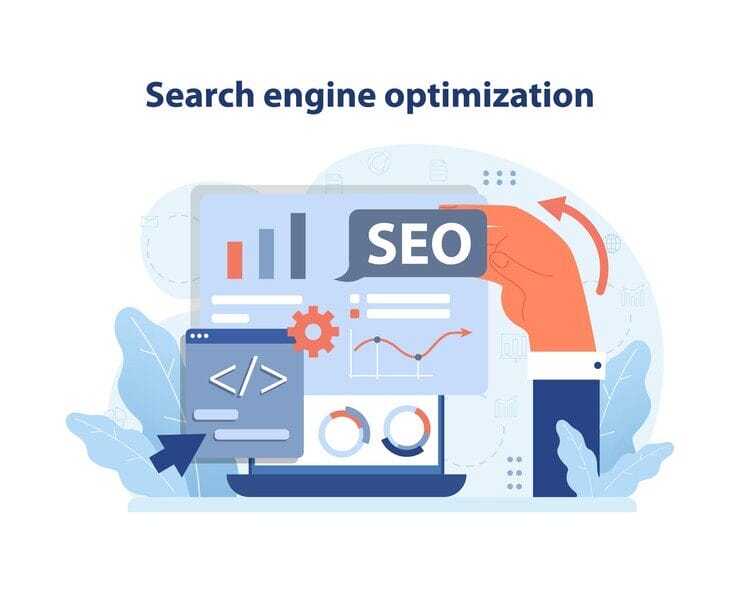How to Create an SEO-Friendly Website Development – Complete Guide
In today’s competitive online landscape, optimizing your website for search engines is essential for visibility and growth.
Since 68 percent of online experiences start with a query in a search engine, therefore it ensures that both the search engines and the users will have no difficulty finding your pages, thereby increasing the chances of getting to higher rankings, more organic traffic, and improving your credibility.
SEO is no longer just a nice-to-have for businesses looking to reach their target efficiently. In this article, we explain the importance of SEO-friendly web development and share 14 ways to optimize your website for Google and other search engines.
Why Having an SEO-Friendly Website is Important?

Starting your website with a solid SEO strategy can significantly boost its success. One key benefit is increased credibility, as users tend to trust sites that appear at the top of search results, making your brand an authority in its field.
An SEO-friendly responsive design enhances user experience, a crucial ranking factor for search engines like Google, improving overall satisfaction. Additionally, SEO is cost-effective, helping you generate leads and sales without relying heavily on paid ads.
It also drives more traffic, with the top search result getting a substantial portion of clicks. Ignoring SEO could mean missing out on a valuable opportunity to make your website a business asset. Prioritizing SEO is essential for your online marketing efforts.
How to Build SEO-Friendly Website?
When you create an SEO-friendly website, it is vital to work constantly and increase your online presence through digital marketing services. Additionally, improving your website rankings may take some time. Here are 14 tips that will help your website to appear on the top –
1) Use Keywords Throughout Your Content

Creating SEO-friendly content on your website is essential for improving your website’s ranking on search engine result pages (SERPs). To identify relevant terms, conduct keyword research.
For instance, searching for “pet toys” might also reveal keywords like “dog toys” and “pet supplies.” Tools like Google Trends and Ahrefs can help you understand popular topics and search intent.
Google Trends compares search terms over time, while Ahrefs provides advanced metrics like keyword volume and traffic potential. Once you have your keywords, use them naturally and strategically in your website content to enhance readability and user experience, boosting your chances of ranking higher on SERPs.
2) Use Header Tags
To make your website SEO-friendly, use header tags effectively. These HTML elements, ranging from <h1> to <h6>, structure your content and help search engines understand it better.
Focus on <h1> for the main title and <h2> for subheadings, and include relevant keywords. Once you have optimized <h1>, add keywords to other headers.
This approach will help search engines recognize and index your content accurately. As a result, your page rankings will improve on search engine results pages (SERPs), allowing you to reach the right audience.
3) Have a Clean URL Structure
The website should have a clean, simple SEO-friendly URL. URLs are the words that search engines read and index in web pages. They must, therefore, be clear and relevant to the content on the page, and including particular keywords within them will help search engines know what topic is being discussed, for example,
www.example.com/seo-friendly-web-development.
Additionally, avoid using long URLs that contain numbers or unnecessary characters. SEO-friendly URLs can increase your potential for a website with a higher ranking in search results, thus bringing more traffic to your site.
4) Include Keyword-Rich Anchor Text in Your Links
Anchor texts are clickable words or phrases that link to another page on a website. Using SEO-friendly anchor texts helps search engines understand the content and rank it better. To create anchor text, use relevant keywords that describe what the linked page is about.
For instance, if linking to a page about SEO tips, choose phrases like “Learn SEO tips” or “SEO strategies.” Ensure the anchor text is clear and closely related to the linked content. Avoid stuffing too many keywords, as this can harm your SEO performance. Keep it natural and relevant for the best results.
5) Make Sure the Website is Mobile Friendly

Creating a mobile-friendly website goes beyond optimizing content—it also involves ensuring mobile-friendliness. With mobile users accounting for nearly 59% of global web traffic in 2022, search engines like Google prioritize mobile-friendly sites in rankings.
Your website should load quickly on mobile devices and have a responsive web design that adapts to different screen sizes. Most WordPress and other website platform themes come with built-in mobile versions.
Use tools like Google’s Mobile-Friendly Test to check if your site meets current mobile optimization standards and stays competitive in search results.
6) Optimize Image
Optimizing images for SEO can significantly improve your website’s visibility. Start by giving each image a descriptive file name with relevant keywords. It helps search engines understand the content.
Compress images to reduce their size without losing quality, ensuring page load is faster, which boosts SEO. Always include alt text that describes the image for better accessibility and SEO benefits.
Alt text helps search engines recognize what the image is about, even if it doesn’t load. Lastly, adding captions can enhance user experience and provide additional context, further strengthening your SEO strategy.
7) Make Sure Your Web Pages Load Fast
Search engines prioritize fast-loading websites that offer a great user experience. A slow site can damage your SEO efforts, frustrate customers, and hinder search engines from effectively crawling your content.
To optimize your website, start by reducing server response times and optimizing HTTP requests. Compress images and media files to maintain quality while decreasing their size.
Implement browser caching to store frequently accessed files locally, and use a content delivery network (CDN) to distribute hosting across multiple servers. Finally, consider upgrading to a better web hosting plan and utilize tools like Google’s Page Speed Insights for performance insights.
8) Use Social Media to Promote Your Content
Promoting your content on social media is an effective way to enhance your website’s SEO. By sharing your content, you can reach a broader audience, leading to more backlinks that search engines use for rankings.
To grow your brand through social media, it’s essential to understand which platforms align with your niche; for instance, Pinterest and Instagram may not drive much traffic overall but can be powerful for topics like fashion and food.
Remember to include referral links and compelling calls to action (CTAs) in your profiles and posts, as these can significantly increase traffic to your website.
9) Use Google Tools

To make your website SEO-friendly, it’s essential to analyze core metrics using tools like Google Search Console and Google Analytics. These tools help track your site’s performance and guide you on submitting it correctly to search engines, ensuring it gets indexed and visible in search results.
Even if you are on a budget, many tools are free. Google Search Console shows how your site performs in searches, providing insights on organic traffic and errors like broken links or duplicate content. Meanwhile, Google Analytics offers valuable metrics, such as bounce rates, helping you identify areas for improvement.
10) Code Cleanup and Organization
As your website expands, the numerous lines of code that enable its functions can become tangled and disorganized, leading to potential issues. Regularly cleaning up this code is essential to maintain performance and ensure smooth operation.
This cleanup not only helps improve the website speed at which your site loads but also aids in better search engine indexing, which is crucial for boosting your SEO.
Websites typically use various programming languages, with HTML, CSS, and JavaScript being the most common, each having its structure and organization. Keeping them tidy is vital for your site’s success.
11) Add Internal Links
Internal linking involves adding hyperlinks within your content that connect to other pages on your website. This strategy not only helps search engines understand the structure and relevance of your site but also improves navigation for visitors.
You can link to text, images, or buttons, ensuring the links are relevant to the content. Effective internal linking can reduce bounce rates by guiding users to related content and encouraging them to engage more with your site.
However, it’s important to avoid excessive linking, as too many hyperlinks can clutter your content and diminish the user experience. Tools like Yoast SEO can assist in optimizing your internal links.
12) Optimize the Title Tags and Meta Descriptions
Title tags and meta descriptions are important in how your content appears in search results. The title tag acts as a clickable headline, while the meta description offers a brief overview of what readers can expect.
To optimize these elements, include your focus keyword in the title tag and ensure it aligns with your audience’s search intent. Aim for a title length of 50–60 characters to enhance visibility. For meta descriptions, use up to 155–160 characters to concisely convey your content’s value.
13) Enhance Content With Images and Videos

Elements like images and videos can significantly enhance your content’s appeal. They not only make the text more engaging but also help convey complex data clearly through graphs and charts.
Furthermore, these visuals can improve your SEO by making your content visible in Google’s image and video search results, increasing click-through rates. Additionally, rich snippets featuring your media can appear at the top of search results, grabbing more attention.
To ensure a seamless user experience, it is crucial to optimize your images and videos by compressing their sizes and adding relevant alt text.
14) Update Your Content Regularly
Regularly creating new content is an effective SEO strategy, but it can be challenging to generate fresh ideas. In such cases, consider updating older content to enhance your website’s SEO.
Balancing new and updated content keeps your audience engaged and attracts new visitors. Ensure your updates address current topics to maintain interest among your target audience.
Remember, employing solid SEO techniques alone isn’t sufficient; you must also provide valuable information to your visitors. Focus on crafting high-quality content that benefits your audience and helps strengthen your brand’s reputation.
Summary: Create an SEO-Friendly Website Design Today!
Building an SEO-friendly site requires technical optimization, content strategy, and user-focused design. Follow the series of steps in this guide to develop a site that ranks well on search engines, drives organic traffic, and offers the best user experience.
When designing a website or optimizing an existing one, heed the best practices outlined here to succeed in the digital landscape of the future. At Surgeboom, our SEO-friendly web development ensures your website ranks higher, performs better, and grows your business faster.
Frequently Asked Questions
1) What is SEO in web development?
SEO in web development may be defined as building and developing a website aimed at achieving the best SEO perspective in web development. The content of the website, from code and images to even URL structure, should be optimized to ensure that the search engine can crawl and index it without much difficulty.
2) What do you mean by an SEO-friendly website?
A friendlier SEO website is a website optimized for users and search engines. This implies that the website is marked by clean code, optimized content, fast-loading page speeds, mobile responsiveness, and proper use of keywords, title tags, and meta descriptions to rank higher in the search engine results.
3) What is SEO-friendly coding?
Where SEO-friendly coding is writing clean, structured, and efficient HTML, CSS, and JavaScript that actually improves the performance of a site but can be quickly crawled and indexed by search engines, on the other hand, the removal of unnecessary code and proper heading tags, alt text, etc. come under it.

